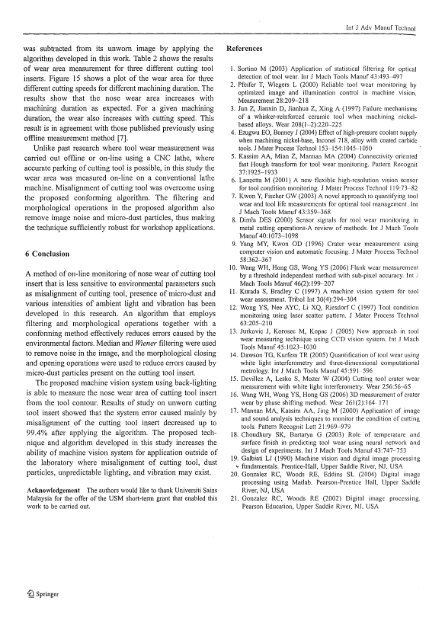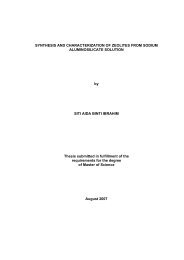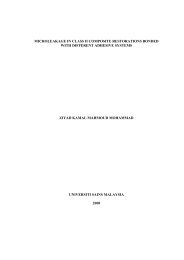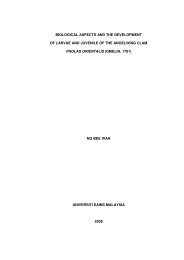Laporan Akhir Projek Penyelidikan Jangka Pendek ... - ePrints@USM
Laporan Akhir Projek Penyelidikan Jangka Pendek ... - ePrints@USM
Laporan Akhir Projek Penyelidikan Jangka Pendek ... - ePrints@USM
You also want an ePaper? Increase the reach of your titles
YUMPU automatically turns print PDFs into web optimized ePapers that Google loves.
[nt J Adv Manuf Technolwas subtracted from its unwom image by applying thealgorithm developed in this work. Table 2 shows the resultsof wear area measurement for three different cutting toolinserts. Figure 15 shows a plot of the wear area for threedifferent cutting speeds for different machining duration. Theresults show that the nose wear area increases withmachining duration as expected. For a given machiningduration, the wear also increases with cutting speed. Thisresult is in agreement with those published previously usingoffline measurement method [7].Unlike past research where tool wear measurement wascan'ied out offline or on-line using a CNC lathe, whereaccurate parking ofcutting tool is possible, in this study thewear area was measured on-line on a conventional lathemachine. Misalignment of cutting tool was overcome usingthe proposed confOlming algorithm. The filtering andmorphological operations in the proposed algorithm alsoremove image noise and micro-dust particles, thus makingthe technique sufficiently robust for workshop applications.6 ConclusionA method ofon-line monitoring ofnose wear of cutting toolinsert that is less sensitive to environmental parameters suchas misalignment of cutting tool, presence of micro-dust andvarious intensities of ambient light and vibration has beendeveloped in this research. An algorithm that employsfiltering and morphological operations together with acontonning method effectively reduces errors caused by theenvironmental factors. Median and Wiener filtering were usedto remove noise in the image, and the morphological closingand opening operations were used to reduce errors caused bymicro-dust particles present on the cutting tool insert.The proposed machine vision system using back-lightingis able to measure the nose wear area of cutting tool insertfrom the tool contour. Results of study on unworn cuttingtool insert showed that the system error caused mainly bymisalignment of the cutting tool insert decreased up to99.4% after applying the algorithm. The proposed techniqueand algorithm developed in this study increases theability of machine vision system for application outside ofthe laboratory where misalignment of cutting tool, dustparticles, unpredictable lighting, and vibration may exist.Acknowledgement The authors would like to thank Universiti SainsMalaysia for the offer of the USM short-term grant that enabled thiswork to be carried out.ReferencesI. Sortino M (2003) Application of statistical filtering for opticaldetection of tool wear. [nt J Mach Tools Manuf 43 :4934972. Pfeifer T, Wiegers L (2000) Reliable tool wear monitoring byoptimized image and illumination control in machine vision.Measurement 28:209-2183. Jun Z, Jianxin D, Jianhua Z, Xing A (1997) Failure mechanismsof a whisker-reinforced ceramic tool when machining nickelbasedalloys. Wear 208(1-2):220-2254. Ezugwu EO, Bonney J (2004) Effect of high-pressure coolant supplywhen machining nickel-base, lnconel 718, alloy with coated carbidetools. J Mater Process Technol 153·154: I045·10505. Kassim AA, Mian Z, Mannan MA (2004) Connectivity orientedfast Hough transform for tool wear monitoring. Pattern Recognit37:1925-19336. Lanzetta M (2001) A new flcxible high-resolution vision sensorfor tool condition monitoring. J Mater Process Technol 119:73-827. Kwon Y, Fischer GW (2003) A novel approach to quantifying toolwear and tool life measurements for optimal tool management. IntJ Mach Tools Manuf 43:359-·3688. Dimla DES (2000) Sensor signals for tool wear monitoring inmetal cutting operations-A review of methods. [nt J Mach ToolsManuf 40: [073-10989. Yang MY, Kwon OD (1996) Crater wear measurement usingcomputer vision and automatic focusing. J Mater Process Technol58:362-36710. Wang WH, Hong GS, Wong YS (2006) Flank wear measurementby a threshold independent method with sub-pixel accuracy. Int .JMach Tools Manuf 46(2): 199-20711. Kurada S, Bradley C (1997) A machine vision system for toolwear assessment. Tribol Int 30(4):294-30412. Wong YS, Nee AYC, Li XQ, Riesdorf C (1997) Tool conditionmonitoring using laser scatter pattern. J Mater Process Technol63:205-21013. Jurkovic J, Korosec M, Kopac J (2005) New approach in toolwear measuring technique using CCD vision system. Int J MachTools Manuf 45: 1023 .. 103014. Dawson TG, Kurfess TR (2005) Quantification of tool wear usingwhite light interferometry and three-dimensional computationalmetrology. Int J Mach Tools ManuI' 45:59159615. Devillez A, Lesko S, Mozer W (2004) Cutting tool crater wearmeasurement with white light interferometry. Wear 256:56-6516. Wang WH, Wong YS, Hong GS (2006) 3D measurement of craterwear by phase sh ifting method. Wear 261 (2): 164 17117. Mannan MA, Kassim AA, Jing M (2000) Application of imageand sound analysis techniques to monitor the condition of cuttingtools. Pattern Recognit Lett 21 :969-97918. Choudhury SK, Bartarya G (2003) Role of temperaturc andsurface finish in predicting tool wear using neural network anddesign of experiments. Int J Mach Tools Manuf 43:747-75319. Galbiati LJ (1990) Machine vision and digital image processing.,. fundamentals. Prentice-Hall, Upper Saddle River, NJ, USA20. Gonzalez RC, Woods RE, Eddins SL (2004) Digital imageprocessing using Matlab. Pearson-Prentice Hall, Upper SaddleRiver, NJ, USA21. Gonzalez RC, Woods RE (2002) Digital image processing.Pearson Education, Upper Saddle River, NJ, USA~ Springer
















